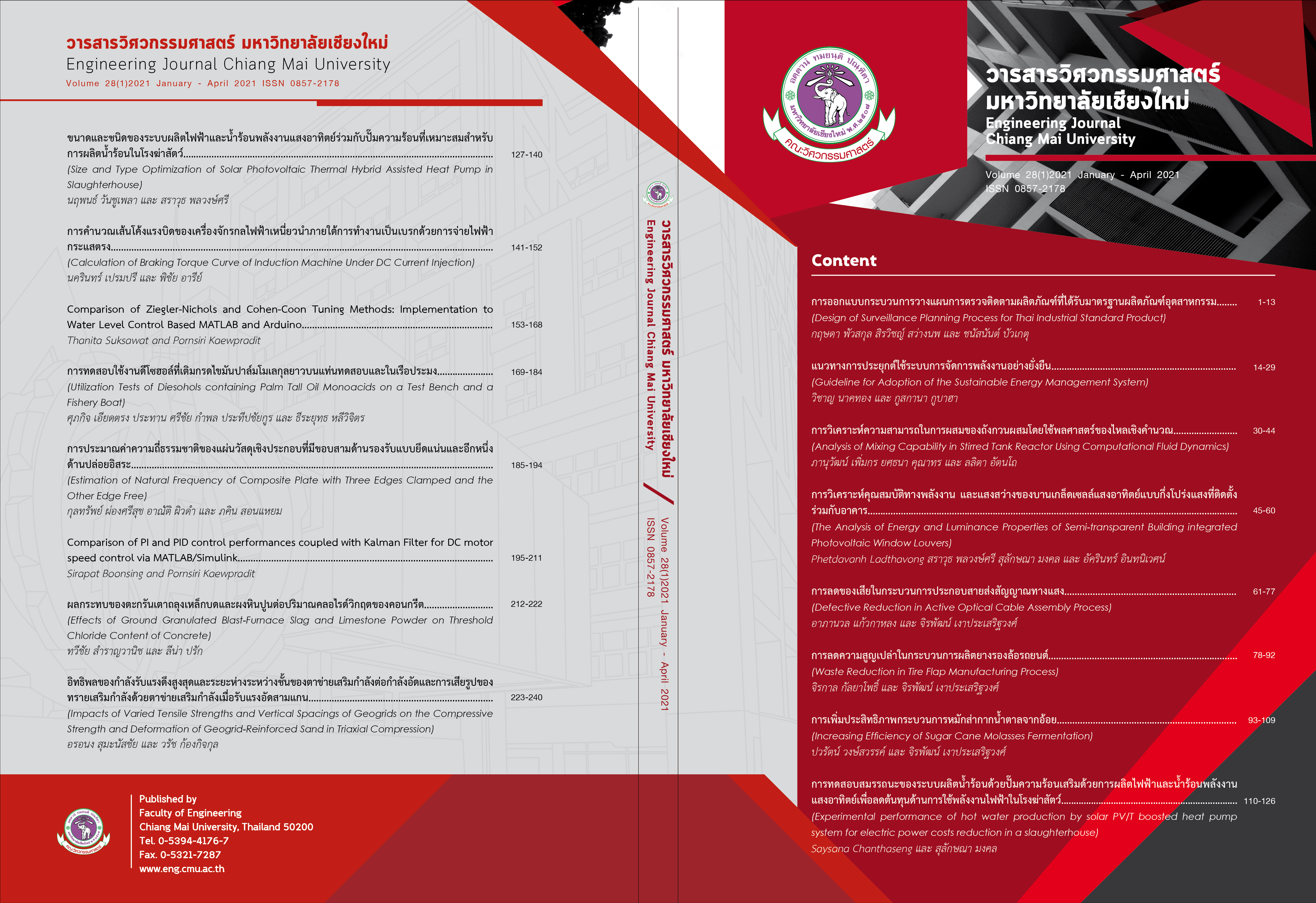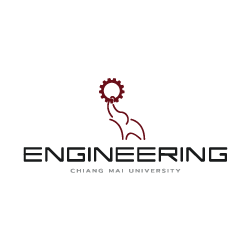Guideline for Adoption of the Sustainable Energy Management System
Keywords:
Sustainable Energy Management, ISO 50001, Key Process Input VariablesAbstract
This research was to propose guidelines for adoptatipon international standard energy management systems (ISO 50001: 2018) for effectiveness and sustainability. Researches, Energy Management Standards, and relevant energy management guidedance were studied and reviewed. Together with information and data colection of the 18 best practice energy management systems industries according to the PDCA was surveyed. The results of study presented the ideas for analyzing energy management systems as sub-processes in the management process frame works and the analysis of key process input variables (KPIVs) of each process influencing on the deviations of the quality level and sustainability of energy management systems. The application guidelines for the sustainable energy management systems are the key process guidelines to control the input variables of the energy management system in order to reduce the risk or deviation that will affect the result of each process which is the crucial part of sustainable energy management systems.
References
Pinero, E.ISO 50001: Setting the Standard for Industrial Energy Management.Green Manufacturing News, 2009;21-24.
ISO 50001 Energy Management System Requirements with Guidance for Use.International Organizationfor Standardization, 2011.
World Outlook.International Energy Agency(IEA), 2013.[Online]Available: https://www.iea.org/Textbase/npsum/WEO2013SUM.pdf.
Division for Sustainable Development Goals. Department of Economic and Social AffairsUnitedNations, Sustainable Development Goals,2020.[Online], Available:https://sustainabledevelopment.un.org/sdg7.
พระราชบัญญัติการส่งเสริมการอนุรักษ์พลังงาน พ.ศ. 2535.กรมพัฒนาพลังงานทดแทนและอนุรักษ์พลังงาน กระทรวงพลังงาน,2535.
พระราชกฤษฎีกาก าหนดโรงงานควบคุมพ.ศ.2540. กรมพัฒนาพลังงานทดแทนและอนุรักษ์พลังงาน กระทรวงพลังงาน,2540.
พระราชบัญญัติการส่งเสริมการอนุรัษ์พลังงาน ฉบับที่ 2 พ.ศ.2550. กรมพัฒนาพลังงานทดแทนและอนุรักษ์พลังงาน กระทรวงพลังงาน,2550.
แผนอนุรักษ์พลังงาน 20 ปี (พ.ศ.2558–2579). กระทรวงพลังงานกระทรวงพลังงาน,2562.[ระบบออนไลน์] แหล่งที่มา: http://www.eppo.go.th/index.php/th/plan-policy/tieb/eep.
สถานะการส่งรายงานการจัดการพลังงาน.กรมพัฒนาพลังงานทดแทนและอนุรักษ์พลังงาน, 2562.[Online], Available:https://eform.dede.go.th/report/xPage2.php?prog_id=ef04dc18&type=1.
ISO Survey. International Organization for Standardization, 2017.[Online], Available: https://www.iso.org/iso/iso-survey.
Hasanbeigi, A.,Menke, C. and du Pont, P.Barriers to Energy Efficiency Improvement and Decision-Making Behavior in Thai Industry. Energy Efficiency, 2010;3(1):33–52.
Nakthong, V. and Kubaha, K.Development of a Sustainability Index for an Energy Management System in Thailand.Sustainability,2019;11(4587): 1-24.
Key Process Input Variables. 2563.[Online], Available:https://www.techopedia.com/definition/30844/key-process-input-variable-kpiv.
Bottcher, C.and Müller, M.Insights on the Impact of Energy Management Systems on Carbon and Corporate Performance. An Empirical Analysis with Data from German Automotive Suppliers. Journal of Cleaner Production, 2016; 137: 1449-1457.
MaKane, A.Industrial Energy Management. Meeting on Using Energy Management Standards to stimulate persistent application of Energy Efficiency in Industry, March 21-22, Vienna, Austria, 2007.
Energy Management-Specification. Danish Standards Association, 2001, DS 2403:2001, Charlottenlund, Denmark, 2001.
IS 393:2005 Energy Management Systems–Requirements with Guidance for Use. National Standards Authority of Ireland (NSAI), 2005.
A Management System for Energy.The American National Standards Institute, ANSI/MSE 2000:2008.
ISO 50001 Energy Management System-Requirements with Guidance for Use. International Organization for Standardization, 2018.
ISO 50004 Energy management systems-Guidance for the Implementation, Maintenance and Improvement of an Energy ManagementSystem.International Organization for Standardization, 2020.
Marimon, F.and Casadesús, M. Reasons to Adopt ISO 50001 Energy Management System. Sustainability2017;9:1740.
Beihmanis, K.and Rosa, M.Energy Management System Implementation in Latvian Municipalities: from Theory to Pactice. Energy Procedia, 2016; 95: 66-70.
Javanovic, B.,Filipovic, J.and Bakic, V.Energy Management System Implementation in Serbian Manufacturing -Plan-Do-Check-Act Cycle Approach.Journal of Cleaner Production, 2017; 162: 1144-1156
Gonzalez, A.,Castrillon, R.and Quispe, E.Energy Efficiency Improvement in the Cement Industry Through Energy Management.Cement Industry Technical Conference, May 13-17, San Antonio, Texas, USA, 2012.
Gopalakrishnana, B.,Ramamoorthya, K.,Croweb, E.,Chaudharic, S.andLatifa, H.A Structured Approach for Facilitating the Implementationof ISO 50001 Standard in the Manufacturing Sector.Sustainable Energy Technologies and Assessments,2014; 7: 154–165
.[26]Kanneganti, H., Gopalakrishnan, B., Crowe, E., Al-Shebeeb, O., Yelamanchi, T., Nimbarte, A., Currie, K., andAbolhassani, A.Specification of Energy Assessment Methodologies to Satisfy ISO 50001 Energy Management Standard.Sustainable Energy Technologies and Assessments, 2017; 23:121–135.
Chiu, T.Y., Lo, S.L.and Tsai, Y.Y. Establishing an Integration-Energy-Practice Model for Improving Energy Performance Indicators in ISO 50001 Energy Management Systems.Energies,2012; 5:5324-5339.
Antunes, P., Carreira, P.and Silva, M.Toward an Energy Management Maturity Model.Energy Policy, 2014; 73:803-814.
Javanovic, B. and Filipovic, J.ISO 50001 Standard-Based Energy Management Maturity Model-Proposal and Validation in Industry. Journal of Cleaner Production, 2016; 112:2744-2755.
Lopes de Sousa Jabbour, A.B.,Júnior, S.A.V.,Jabbour, C,J.C., Filho, W.L.,Campos, L.S.and De Castro,R.Toward Greener Supply Chains: is There a Role for the New ISO 50001 Approach to Energy and Carbon Management?.Energy Efficiency, 2017; 10:777–785.
Bunse, K., Vodicka, M., Schönsleben, P., Brülhart, M., and Ernst, F.O.Integrating Energy Efficiency Performance inProduction Management -Gap Analysis between Industrial Needs and Scientific Literature.Journal of Cleaner Production, 2011; 19: 667-679.
กฎกระทรวงก าหนดมาตรฐาน หลักเกณฑ์ และวิธีจัดการพลังงานในโรงงานควบคุมและอาคารควบคุมพ.ศ.2552.กรมพัฒนาพลังงานทดแทนและอนุรักษ์พลังงาน กระทรวงพลังงาน, 2552.
กฎกระทรวงก าหนดคุณสมบัติหน้าที่และจ านวนของผู้รับผิดชอบด้านพลังงาน พ.ศ.2552. กรมพัฒนาพลังงานทดแทนและอนุรักษ์พลังงาน กระทรวงพลังงาน,2552.
กฎกระทรวงก าหนดคุณสมบัติของผู้ขอรับใบอนุญาต หลักเกณฑ์วิธีการ และเงื่อนไขการขอรับใบอนุญาต และการอนุญาตตรวจสอบและรับรองการจัดการพลังงานพ.ศ.2552. การตรวจสอบรับรอง กรมพัฒนาพลังงานทดแทนและอนุรักษ์พลังงาน กระทรวงพลังงาน, 2552.
การพัฒนาต่อยอดการด าเนินการจัดการพลังงานตามกฎหมายประเทศไทย. กองก ากับและอนุรักษ์พลังงาน กรมพัฒนาพลังงานทดแทนและอนุรักษ์พลังงาน กระทรวงพลังงาน, 2559.
Ramos, E, 2019. Identifying Risks with SWOT Analysis in 3 Steps.2563.[Online], Available:https://medium.com/techcatch/identifying-risks-with-swot-analysis-in-3-steps-38aa033ed886.
ISO 50004 Energy Management Systems -Guidance for the Implementation, Maintenance and Improvement of an ISO 50001 Energy Management System. International Organization for Standardization, 2014.
ISO 50002 Energy audits-Requirements with Guidance for Use. InternationalOrganization for Standardization, 2014.
ISO 50006 Energy Management Systems-Measuring Energy Performance Using Energy Baselines (Enb) and Energy Performance Indicators (EnPI) -General Principles and Guidance.International Organization for Standardization, 2014.
Wodtke, C.Introduce to OKRs. 2016.[Online], Available: https://www.oreilly.com/business/free/files/introduction-to-okrs.pdf.
Roberts, J., Smith, B., and Yellapnatul, S.Staff Competencies Training Matrix. University of Florida, USA, 2015.
Javieda, T., Rackowa, T., and Franke, J.Implementing Energy Management System to Increase Energy Efficiency in Manufacturing Companies.Procedia CIRP, 2015; 26:156–161.
ISO 50015 Energy management systems -Measurement and verification of energy performance of organization -Genral principle and guidance. International Organization for Standardization, 2014.
ISO 19011-Guidelines for Auditing Management Systems. International Organization for Standardization, 2018.
Downloads
Published
Issue
Section
License
ลิขสิทธิ์ของบทความที่ตีพิมพ์ในวารสารฉบับนี้จะยังเป็นของผู้แต่งและยินยอมให้สิทธิ์เผยแพร่กับทางวารสาร
การเผยแพร่ในระบบวารสารแบบเปิดนี้ บทความจะสามารถนำไปใช้ได้ฟรีในการศึกษา และในทางที่ไม่เกี่ยวกับการค้า




